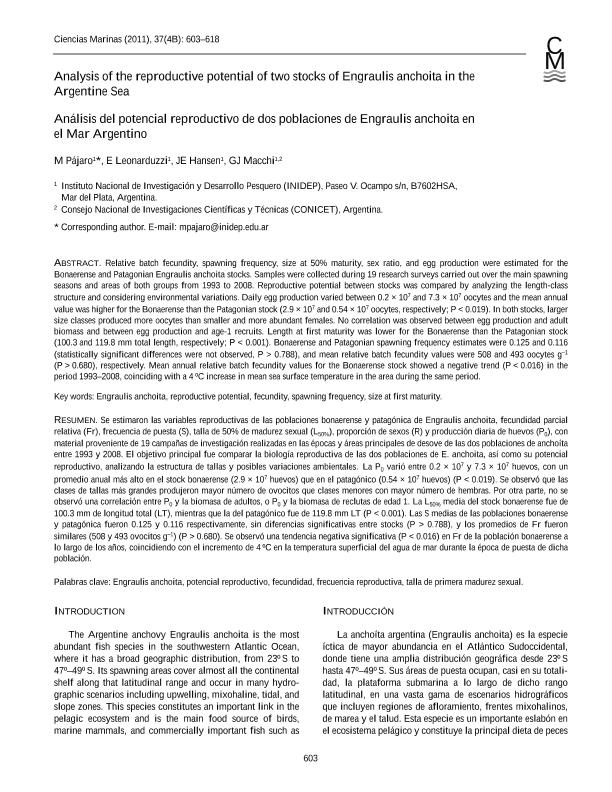Artículo
Relative batch fecundity, spawning frequency, size at 50% maturity, sex ratio, and egg production were estimated for the Bonaerense and Patagonian Engraulis anchoita stocks. Samples were collected during 19 research surveys carried out over the main spawning seasons and areas of both groups from 1993 to 2008. Reproductive potential between stocks was compared by analyzing the length-class structure and considering environmental variations. Daily egg production varied between 0.2 × 107 and 7.3 × 107 oocytes and the mean annual value was higher for the Bonaerense than the Patagonian stock (2.9 × 107 and 0.54 × 107 oocytes, respectively; P < 0.019). In both stocks, larger size classes produced more oocytes than smaller and more abundant females. No correlation was observed between egg production and adult biomass and between egg production and age-1 recruits. Length at first maturity was lower for the Bonaerense than the Patagonian stock (100.3 and 119.8 mm total length, respectively; P < 0.001). Bonaerense and Patagonian spawning frequency estimates were 0.125 and 0.116 (statistically significant differences were not observed, P > 0.788), and mean relative batch fecundity values were 508 and 493 oocytes g–1 (P > 0.680), respectively. Mean annual relative batch fecundity values for the Bonaerense stock showed a negative trend (P < 0.016) in the period 1993–2008, coinciding with a 4 ºC increase in mean sea surface temperature in the area during the same period. Se estimaron las variables reproductivas de las poblaciones bonaerense y patagónica de Engraulis anchoita, fecundidad parcial relativa (Fr), frecuencia de puesta (S), talla de 50% de madurez sexual (L50%), proporción de sexos (R) y producción diaria de huevos (P0), con material proveniente de 19 campañas de investigación realizadas en las épocas y áreas principales de desove de las dos poblaciones de anchoíta entre 1993 y 2008. El objetivo principal fue comparar la biología reproductiva de las dos poblaciones de E. anchoita, así como su potencial reproductivo, analizando la estructura de tallas y posibles variaciones ambientales. La P0 varió entre 0.2 × 107 y 7.3 × 107 huevos, con un promedio anual más alto en el stock bonaerense (2.9 × 107 huevos) que en el patagónico (0.54 × 107 huevos) (P < 0.019). Se observó que las clases de tallas más grandes produjeron mayor número de ovocitos que clases menores con mayor número de hembras. Por otra parte, no se observó una correlación entre P0 y la biomasa de adultos, o P0 y la biomasa de reclutas de edad 1. La L50% media del stock bonaerense fue de 100.3 mm de longitud total (LT), mientras que la del patagónico fue de 119.8 mm LT (P < 0.001). Las S medias de las poblaciones bonaerense y patagónica fueron 0.125 y 0.116 respectivamente, sin diferencias significativas entre stocks (P > 0.788), y los promedios de Fr fueron similares (508 y 493 ovocitos g–1) (P > 0.680). Se observó una tendencia negativa significativa (P < 0.016) en Fr de la población bonaerense a lo largo de los años, coincidiendo con el incremento de 4 ºC en la temperatura superficial del agua de mar durante la época de puesta de dicha población.
Analysis of the reproductive potential of two stocks of Engraulis anchoita in the Argentine Sea
Título:
Análisis del potencial reproductivo de dos poblaciones de Engraulis anchoita en
el Mar Argentino
Fecha de publicación:
12/2011
Editorial:
Universidad Autónoma de Baja California. Instituto de Investigaciones Oceanológicas
Revista:
Ciencias Marinas
ISSN:
0185-3880
Idioma:
Inglés
Tipo de recurso:
Artículo publicado
Clasificación temática:
Resumen
Archivos asociados
Licencia
Identificadores
Colecciones
Articulos(IIMYC)
Articulos de INSTITUTO DE INVESTIGACIONES MARINAS Y COSTERAS
Articulos de INSTITUTO DE INVESTIGACIONES MARINAS Y COSTERAS
Citación
Pajaro, Marcelo; Leonarduzzi, Ezequiel; Hansen, Jorge; Macchi, Gustavo Javier; Analysis of the reproductive potential of two stocks of Engraulis anchoita in the Argentine Sea; Universidad Autónoma de Baja California. Instituto de Investigaciones Oceanológicas; Ciencias Marinas; 37; 4B; 12-2011; 603-618
Compartir
Altmétricas




